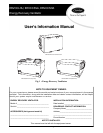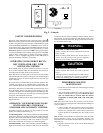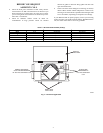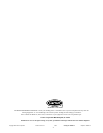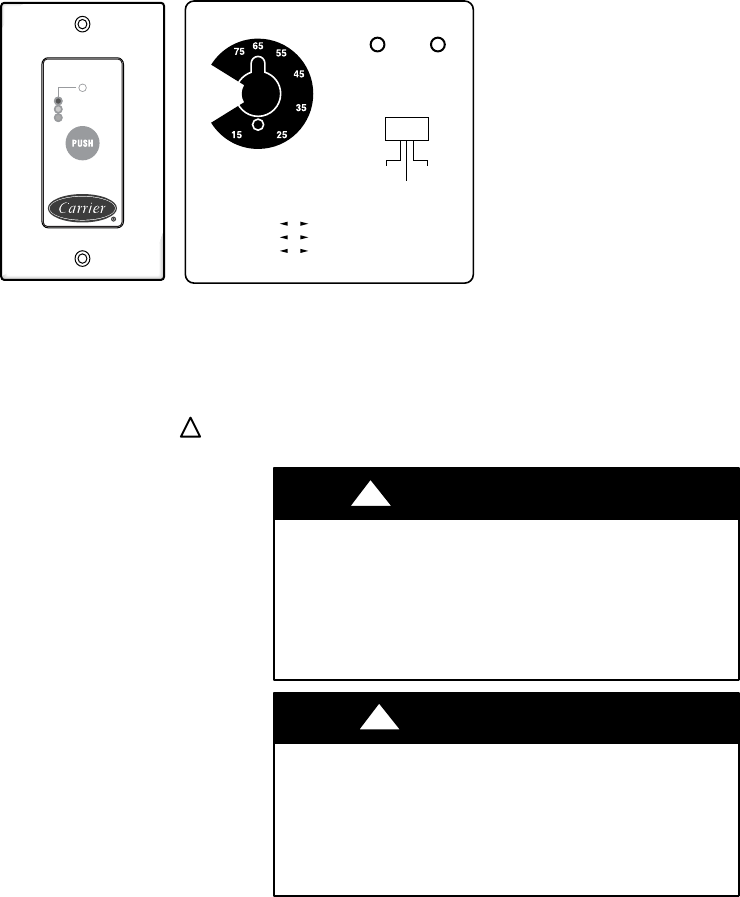
2
OneTouch Control
Latent Control
INTERMITTENT
MAX
MIN
AIR EXCHANGE
OFF LOW
INTERMITTENT
ON
% RELATIVE HUM. EXT. TEMP.
21 C
+
/ 70 F
+
10 C / 50 F
0 C / 32 F
60%
55%
45%
A05367
Fig. 2 -- Controls
SAFETY CONSIDERATIONS
Recognize safety information. This is the safety--alert symbol
!
!
Whenyouseethissymbolontheunitandininstructionsormanuals,
be alertto thepotentialforpersonalinjury.Understand thesesignal
words; DANGER, WARNING, and CAUTION. These wo rds are
used with the safety--alert symbol. DANGER identifies the most
serious hazardswhich will resultinseverepersonalinjury ordeath.
WARNING signifies hazards which could resultin personalinjury
ordeath.CAUTIONisusedtoidentify unsafepracticeswhichmay
result in minor personal injury or product and property damage.
NOTE is used to highlight suggestions which will result in
enhanced installation, reliability, or operation.
OPERATING YOUR ENERGY RECOV-
ERY VENTILATOR (ERV) WITH
ONETOUCH CONTROL
Press “PUSH” until the desired ventilation operation is selected.
Therearethreeselections:High,Low,Intermittent. The powerindi-
cator light indicates which mode has been selected.
High:Thismode isrecommended forthe removalof excess pollu-
tantsandhumidity .Theventilatorwilloperateatitsmaximumspeed
continuously. The power indicator light will be lit red when this
mode is selected.
Low: This mode is recommended for normal daily operation. The
ventilator will operate at its minimum speed continuously. The
power indicator light will belit yellow when this mode is selected.
Intermittent: This mode is recommended when the inside air is too
dry in the heating season or too humid in the cooling season. The
ventilatorwilloperateatitsminimum speedfor20 minutesperhour
and be off for 40 minutes per hour. The power indicator light will
be lit green when this mode is selected.
Off:Toturntheventilatoroff,press“Push”untilthe powerindicator
light is turned off.
OPERATING YOUR ENERGY RECOVERY
VENTILATOR (ERV) WITH BASIC,
STANDARD AND AUTOMATIC CONTROL
Your ERV is designed to operate as an integral part of your total
heating and cooling system (See Fig. 2).
LowExchangeMode—Iftherelativehumidityinside thebuilding
islower than selected, air exchange would occur with the outside at
highspeed.Iftherelativehumidity levelinsidethebuilding ishigh-
er than selected, air exchange would occur outside at low speed.
This ensures continuous air exchange for constant air quality.
IntermittentMode—If the relative humidity inside the building is
higher than selected, no air exchange would occur, and the system
would turn off. If the relative humidity inside the building is lower
than selected, air exchange would occur with outside at high speed.
Thismode isideal formaintaining the proper humidity level when
the continuous mode cannot.
ELECTRICAL SHOCK HAZARD
Failure to follow this warning could result in personal
injury or death.
Before servicing system, always turn off main power to
system. Turn off accessory heater power if applicable.
There may be more than 1 disconnect switch.
!
WARNING
PERSONAL INJURY HAZARD
Failure to follow this caution may result in personal
injury.
Although specialcarehasbeen taken to minimizesharp
edges in the construction of your unit, be extremely
careful when handling p arts or reaching into the unit.
CAUTION
!
PERFORMING ROUTINE
MAINTENANCE
1. The motors are factory lubricated. Lubricating thebearings
is not recommended.
2. Thecoreshouldbevacuumedeverythreemonthstoremove
dustthatwouldinhibittheenergytransfer.Donotusewater.
The core should only be serviced when the outdoor
temperature is between 60°F(16°C) and 75°F(24°C)
and dry.
Note: Iftheedgesofthecoreare soft,do nottry to servicethecore.
Theairpassagescanbedamagedand/orclosedoffbyhandling itor
trying to remove it.
3. A dirty air filter will cause excessive strain on the blower
motor. The filters in your ERV are washable and should be
cleaned every 3 months.Useavacuumcleanertoremovethe
heaviest portion of accumulated dust, then wash in warm
water.
Note: Do NOT clean these filters in a dishwasher or dry them with
heating appliances as they wil be permanently damaged. Use
lukewarm water to clean filters. Replace filters only when they are
completely dry.
4. Regularly check the screen on the exterior intake hood and
clean as necessary.



